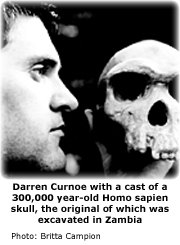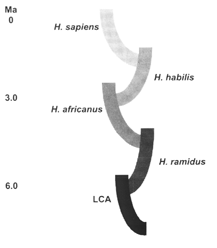

Chiselling
away at the traditional way of thinking
Jacqueline
Nguyen
Biological anthropology
applies biological principles and approaches to the study
of humans. It examines how evolution has shaped us and
compares the way we look and behave with other primates.
Dr Darren Curnoe, a biological anthropologist in UNSW’s
School of Medical Sciences, is investigating human evolution
from a different point of view, opening up new avenues
and even revolutionising the way of thinking in anthropology.
 |
Modelling human evolution
In collaboration with US primatologists and colleagues in South Africa, Dr Darren Curnoe is using living vervet monkeys and baboons to develop models of human evolution. These primates are of interest in gaining insight into our evolution because they share many similarities with early humans. They are terrestrial, have varied diets and are found in the same fossil sites as early humans. “They appear in the fossil record around 3-4 million years ago (MYA) – about the time we see a lot of early humans in the fossil record,” Curnoe says. “Like us, they have a very wide distribution and are found in a range of habitats, yet they’re essentially one species.”
Why not use chimpanzees? Despite being the closest living primate to humans, chimpanzees are not used in the team’s research because no chimpanzee fossils have been found. “Also, modern chimpanzees are restricted to the tropics of Africa; so they don’t have a wide distribution. Whilst they’re genetically much more similar, the Old World monkeys are pretty close – about our fourth or fifth cousins in the evolutionary sense.”
Looking out of Africa… and into East Asia
Curnoe is also working with Dr Alan Thorne from the Australian National University on a project that looks at the role of East Asia in the evolution and origins of modern humans.
“We’re looking at the last 500,000 years of human evolution in East Asia, and trying to get a good handle on how important East Asia is, because it’s been largely neglected,” says Curnoe. “At the moment most of the focus and research interest is on Africa and Europe because of the current and dominant model that says that 100,000 years ago our species evolved in Africa and left Africa.”
Curnoe believes it is now time for a major synthesis of different forms of information, from archaeology to anatomy to genetics, to reconstruct the history of modern humans in East Asia and Australasia.
Curnoe thinks that there is very good evidence of biological links between Australia and Asia. He explains that the earliest Australians would have come from Asia, and that the largest fossil sample for the whole of Asia is found in Australia. The Australian fossil record is also very good; therefore it provides a good sample of what was going on broadly in Asia during that time period.
Curnoe and Thorne hope to gain insight into human migration from the fossil record. “What we’re trying to look at is where there were other populations in East Asia at the time, and we are curious – if people did leave Africa, what happened when they met these (East Asian) people?”
Fossil and archaeological excavations will be conducted, as well as a major review and synthesis of the prehistory of East Asia. Genetic studies will also be conducted to try to put together a picture of what happened in East Asia over this time period.
 An example of a human evolutionary tree. Over 25 species are recognised in the lineage, many of which became extinct without making a genetic contribution to modern humans. Source: Smithsonian Institution [external site] |
The human evolutionary tree
Like many other sciences, biological anthropology can be controversial, especially because it is so close to home. Curnoe and Thorne have studied the genetics of humans and chimpanzees and how close they are using genetic distances.
“After 40 years of research, it is well established that we share about 99% of our DNA. If we place that in a broad context of mammalian genetics, that makes humans and chimpanzees very, very close. We are sister species, which means that we share a common ancestor, somewhere between 7-10 MYA.”
Curnoe and Thorne are the first anthropologists to state that humans and chimpanzees should be placed in the same genus, Homo, based on their research. This raises important ethical issues about how we view and treat other species, particularly chimpanzees.
The pair has taken this work further by coming to terms with how many species there may actually be in the human evolutionary line, given how close humans and chimpanzees are. “The way we have done that is to try to get an idea of how much genetic variation you’d expect to find within a species. We’ve used this as a yardstick, as a measurement of trying to estimate the number of species within the human evolution line.”
“We’ve come out and said, if you look at the genetics and given the short distance between humans and chimpanzees, we don’t believe it’s possible to have that many species,” argues Curnoe.
 Based on genetic analyses, Curnoe and Thorne estimate that there are far fewer number of species on the direct line to modern humans. Source: Curnoe & Thorne (2003) |
At the moment over 25 different species are recognised from the human fossil record. However the pair says there should only be four on the direct line to living humans, and a fifth that became extinct. The four species are H. sapiens (including H. erectus), H. habilis, H. africanus and H. ramidus.
“What we’re talking about is subsuming a lot of the species diversity into a much smaller number of species,” Curnoe says. “If those 40 years of estimates and multiple studies of human-chimp genetics are right, then it must have a profound impact on the way we study human evolution.”
“We try to do it slowly, chisel away at the old way of thinking that says that there are many species, based purely on anatomy – that anatomy of fossil groups is greater than what we see in living humans today, therefore they must be multiple species – is not necessarily the case.”
Curnoe's
investigations in new areas of biological anthropology,
from reconstructing early human history in East Asia to
pruning the human evolutionary tree, has shed more light
on the evolution of our species. His research contributes
to our understanding of human evolution and evolutionary
biology in general, as well as what it is to be human
and how we define ourselves.
Acknowledgments
OnSET
thanks Dr Curnoe for assistance with preparing this article.
See OnSET's Career
Profile: Dr Darren Curnoe
References
Australian Museum - Introduction to Human Evolution website
Curnoe, D. & Thorne, A. (2003) Number of Ancestral Human Species: A Molecular Perspective. Homo, 53, 201-224
Eds Jones, S., Martin, R., Pilbeam, D. (1992) The Cambridge encyclopedia of human evolution. (Cambridge University Press: New York)
Thorne, A. Grün, R. Mortimer, G. Spooner, N.A. McCulloch, M. Taylor, L. and Curnoe, D. (1999) Australia's Oldest Human Remains: Age of the Lake Mungo 3 Skeleton. Journal of Human Evolution 36, 591-612.
Wright, L. (2003) Shaking the Evolutionary Tree. UNSW Uniken Magazine, Issue 4.
Glossary
Paleoanthropology: The study of early humans and non-human primates, and their evolution.
Archaeology: The study of earlier human societies and cultures through their material remains
Old World monkeys: A diverse primate group found throughout sub-Saharan Africa and southern Asia, for example macaques, vervet monkeys, baboons, and colobus monkeys.
OnSET is an initiative of the Science Communication Program
URL: http://www.onset.unsw.edu.au/ Enquiries: onset@unsw.edu.au
Authorised by: Will Rifkin, Science Communication
Site updated: 7 Febuary, 2006 © UNSW 2006 | Disclaimer
OnSET is an online science magazine, written and produced by students.
![]()
OnSET Issue 6 launches for O-Week 2006!
![]()
Worldwide
Day in Science
University
students from around the world are taking a snapshot
of scientific endeavour.
Sunswift
III
The UNSW Solar Racing Team is embarking
on an exciting new project, to design and build the
most advanced solar car ever built in Australia.
![]()
Outreach
Centre for Sciences
UNSW Science students can visit your school
to present an exciting Science Show or planetarium
session.
![]()
South
Pole Diaries
Follow the daily adventures of UNSW astronomers
at the South Pole and Dome C through these diaries.
News in Science
UNSW is not responsible for the content of
these external sites